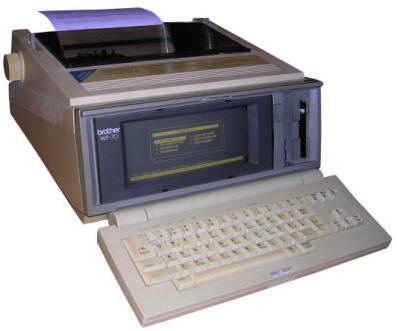Brother WP-70
This is another "intelligent typerwiter" computer from
late 1980s, this time made by Brother, a Japanese company specialized in
printers. These machines were offered with a different regional options
in many countries, but they were popular in Germany as the printout
quality was good and they allowed to store edited text. Additionally
they were cheaper than computers so if you wanted to edit text on
something and had no funds to buy a PC, it was the right choice.
The machine has on-ROM software consisting of a word processor,
spreadsheet with calculation (123-like formula forms - (A2+A3) etc. ) on
demand, software to edit various tables and frames, contact database and
calendar. An on-screen calculator can be started any time. The printer,
being a high-quality daisy-wheel printer, allowed to print and erase
characters using additional eraser tape if the machine was switched to
direct "Typewriter" mode. Font could be changed by changing printer
wheel. Data from all software can be stored on a floppy disks. And here
the problem begins. The floppy format is something very incompatible. It
uses Brother's own implementation of a 3.5" disk drive, with GCR
recording (so no way to read it in PC using MFM), 38 or 40-track disk,
with 12 256-byte sectors on each. Earlier units used 120kB single-sided
disks, this one has 240kB. The "filesystem" makes the file use initially
two sectors weighting 512 bytes. This format is strange and
incompatible, unreadable on any other devices.
With release of WP-100, in Germany LW-100 ca. 1993, Brother started to
slowly run away from this format to a conventional PC floppy format. But
it was not easy - although Brother indeed advertised a DOS program which
could "magically" read older GCR disks, it was never released. I think
that indeed there was such program developed by Brother, but because it
was using some hack like half-stepping (like Amiga's ADFREAD and
Disk2FDI software does), it was too unreliable. So all these LW-70 users
when purchased a new model, with LCD screen, ink-jet printer, graphics
support and DOS compatibility, had NO WAY to read their previous work!
Additionally, Taiwanese PC clones became cheaper and cheaper, finally
making Brother abandon the series. However, especially in Germany, next
models were released as LW-line until late 1990s. The last one, model
LW-840ic being in fact a small computer, was released in 2002.
| Manufacturer | Brother | ||
| Origin | Japan/Germany | ||
| Year of unit | 1992 | ||
| Year of introduction | ??? | ||
| Type | Text processor | ||
| CPU: HD64180 (Z80+MMU) RAM: 64kB ROM: 1MB I/O: Keyboard, amber CRT, Power: Built-in transformer-based power supply Additional capabilities: floppy drive for loading and saving results, built-in daisy-wheel printer (typing + correcting features), beeper.
|
|||
My unit comes from Germany of course. It was used there as
a typewriter in office until ca. 2004.
Technical description:
It is powered with a transformer-based linear PSU, which makes voltages
for amber CRT display, printer and mainboard.
The mainboard is based on HD64180 microprocessor, being in fact a Z80
with memory managemtn unit built-in. There is also 32kB of static RAM
and 64kB of dynamic RAM, probably for buffering and video purposes. The
specialized gate array (upD65046GD091) implements most of system logic.
There are two 512kB (4MBit) ROMs - one, usually socketed, for system
software may be an EPROM, while the other one, soldered in, is a
mask-ROM for spell check dictionary. Although the main software is
located in EPROM, the dictionary is in ROM. The type of ROM is set with
solder pads, the PROM may be Nec upD23C4001E which is not usual - the
functions of CE and OE pins are configurable in programming stage and
pin 1 is a CE/OE pin too.
In my unit, the pin 1 of the chip was active-high Chip Enable, while
pins 22 and 24 were Active Low. This programmable pin 1 is specific to
Nec ROMs and is not present in e.g. UMC 23C4001. That's all if you want
to mess with its system.
The mainboard looks that it was made very, very cheap way. It's
single-sided, with lots of wire bridges, the only SMD chip is the logic
array. Although it was planned to access the board from below, it's not
possible because the keyboard ribbon cable is too short. This style of
making electronics is not characteristic to computers, it's more like a
telephone set or cash register - en masse, as cheap as possible, and
with lots of units returned from testing.
And about this 3-pin connector on the rear... seriously I have no idea.





